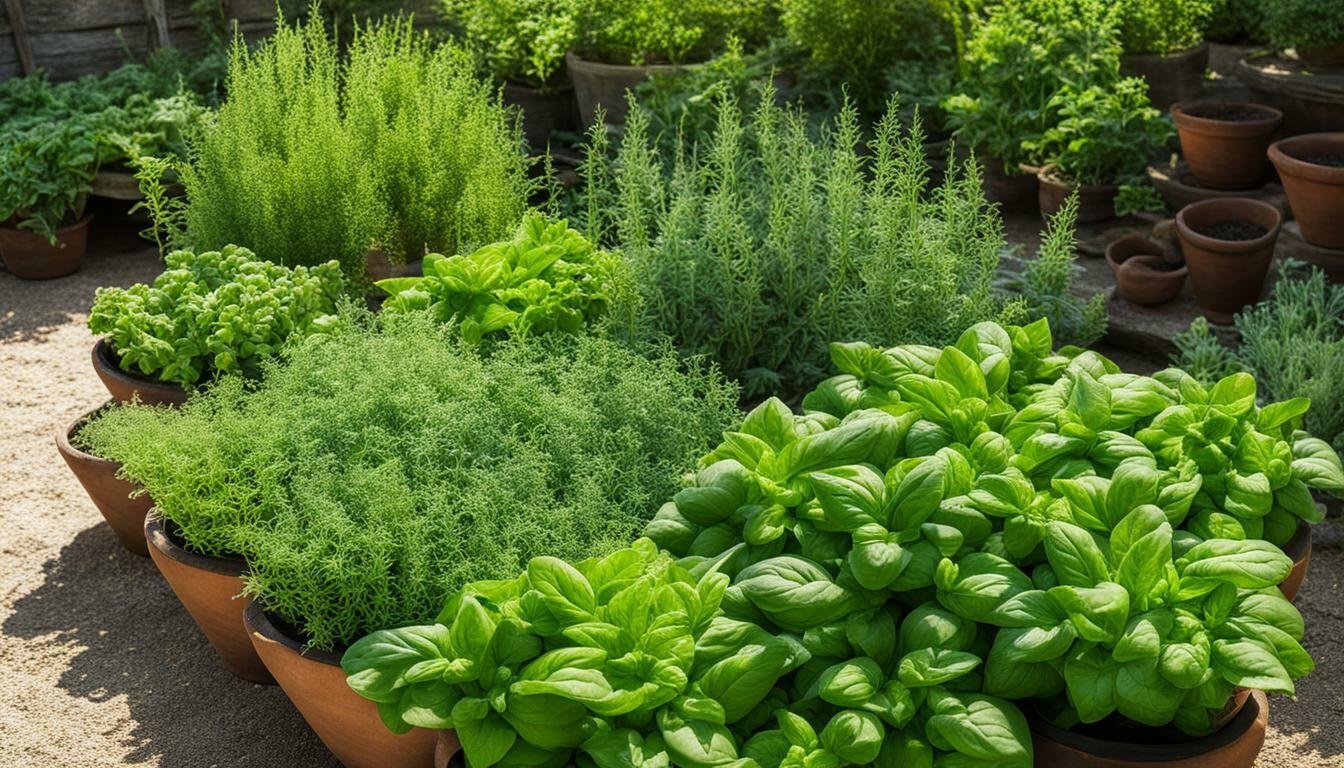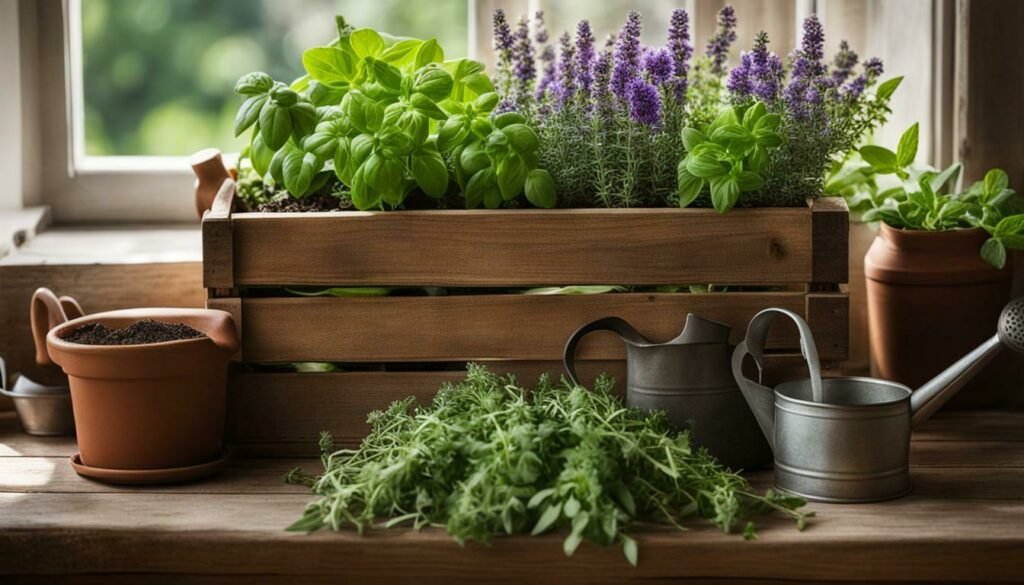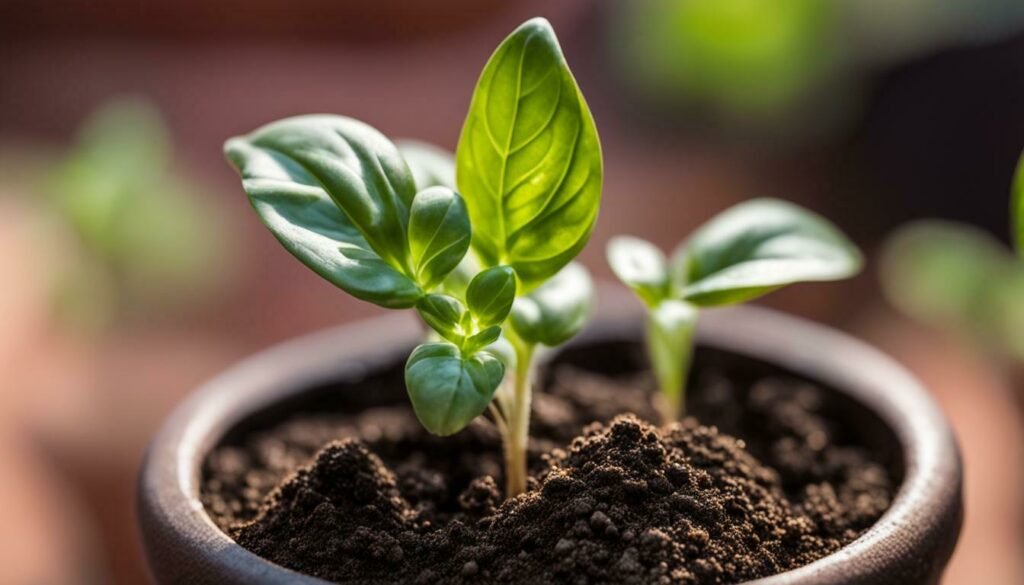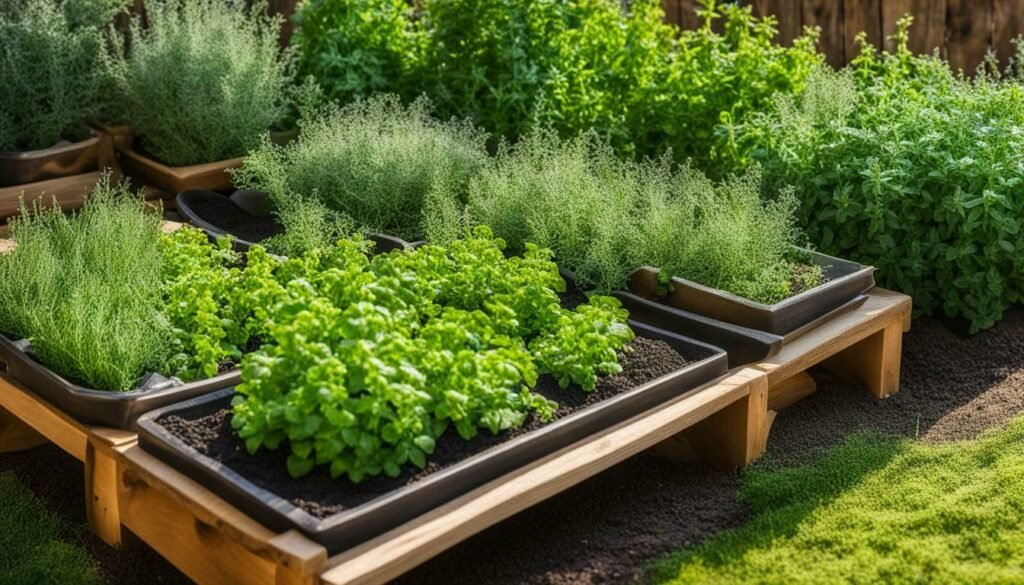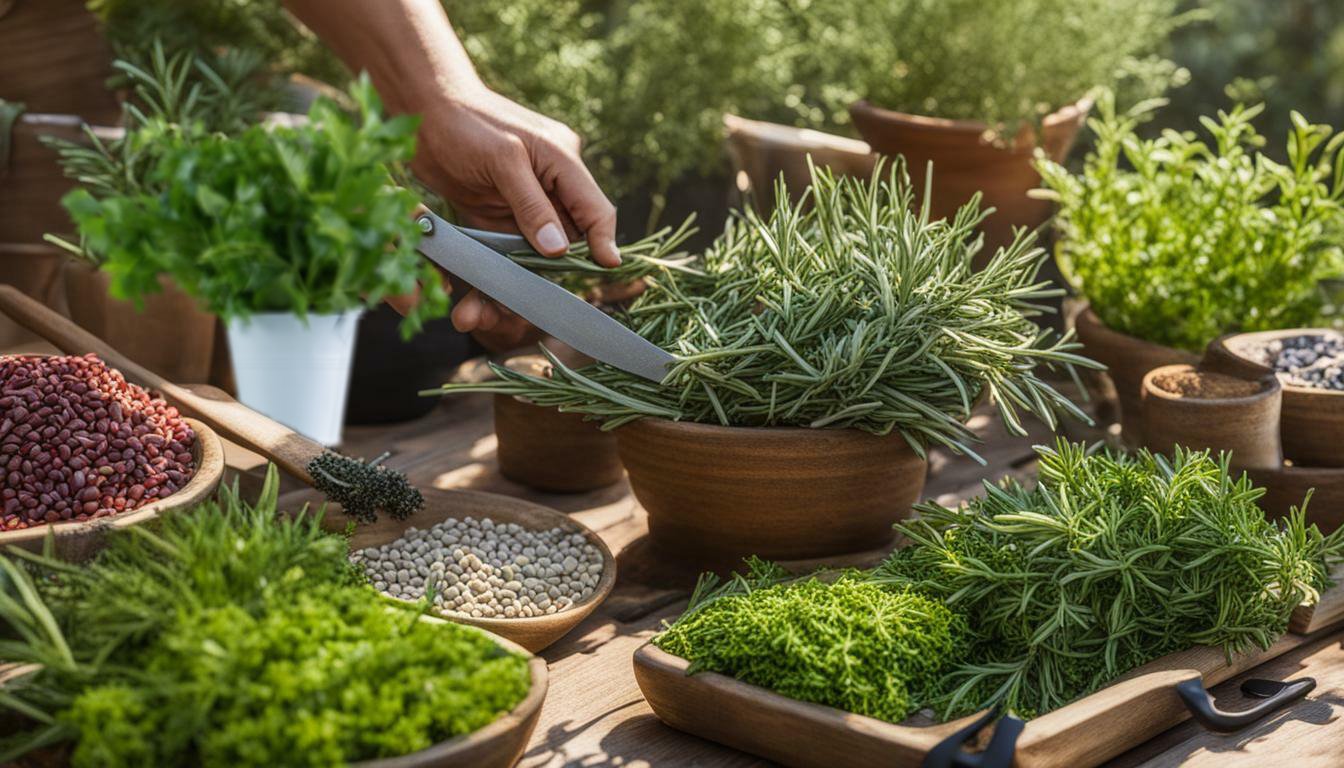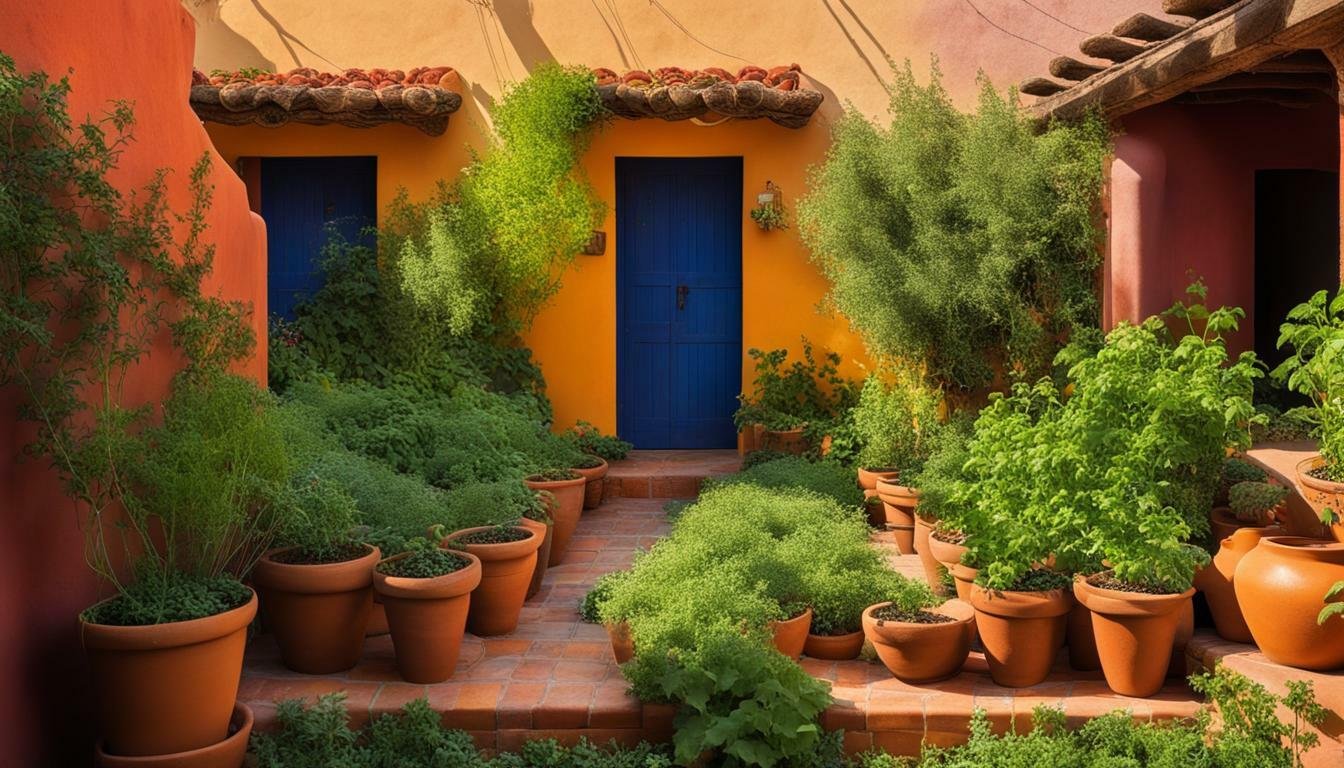Herbs for Italian Cuisine
Growing your own herbs for Italian cuisine is not only a delicious option but also a cost-effective one. By following a few simple steps, you can nurture your own kitchen garden with essential herbs and elevate your Italian dishes to a whole new level.
First, start by hydrating the soil discs and then plant the herb seeds according to the specific instructions on the seed packet. Mist the seeds with water until they sprout, and make sure to keep the soil moist as the seedlings grow. Adding fertilizer will promote healthy leaf growth.
Once the seedlings have grown several inches tall and have at least four true leaves, it’s time to transplant them outdoors. Before fully transplanting, gradually expose the plants to outdoor conditions to harden them off. Remember to thin out the seedlings, allowing room for the strongest ones to grow.
If you prefer to grow herbs indoors, place them in a sunny window location or use grow lights to provide them with the necessary light. To promote bushier growth, harvest the tops of the herb plants regularly.
In addition to Italian herbs, consider including other vegetables like tomatoes and gourmet greens in your herb garden. This will not only add variety to your dishes but also create a visually appealing and bountiful garden.
- Growing your own herbs for Italian cuisine can save you money and enhance the flavor of your dishes.
- Start by hydrating soil discs and planting herb seeds according to instructions.
- Transplant seedlings outdoors, gradually exposing them to outdoor conditions.
- Thin out seedlings to allow room for the strongest ones to grow.
- Growing herbs indoors requires a sunny window location or grow lights.
- Harvest the tops of herb plants to promote bushier growth.
- Consider including other vegetables in your Italian herb garden for variety.
Essential Herbs for Italian Cuisine
When it comes to Italian cooking, there are a few herbs that are considered absolutely essential. These flavorful herbs not only add depth and complexity to Italian dishes but also complement the traditional flavors of the cuisine. To create an authentic taste in your Italian recipes, make sure to include these essential herbs in your herb garden:
- Parsley: This versatile herb is commonly used as a garnish in Italian cooking. Its fresh and bright flavor adds a pop of freshness to pasta dishes, soups, and sauces.
- Genovese Basil: Known as the king of Italian herbs, basil is a staple in Mediterranean cuisine. Its aromatic and sweet taste pairs perfectly with tomatoes, making it an essential ingredient in classic Italian dishes like Caprese salad and Margherita pizza.
- Thyme: With its earthy and slightly minty flavor, thyme is a popular herb in Italian cuisine. It adds a unique touch to roasted vegetables, grilled meats, and pasta sauces.
- Oregano: Oregano is a robust herb that is commonly used in Italian dishes like pizza and pasta sauces. Its strong and slightly bitter flavor elevates the taste of tomato-based recipes.
- Sage: This herb has a warm and savory flavor that pairs well with rich Italian dishes. It is often used in stuffing, pasta fillings, and butter sauces.
- Rosemary: Rosemary has a distinct pine-like aroma and a strong flavor. It is commonly used in roasted meats, bread, and potato dishes.
- Bay Leaf: Although bay leaves are not typically eaten, they are used to infuse flavor into soups, stews, and braised meats. Just remember to remove them before serving.
- Fennel: Fennel has a sweet, licorice-like taste and is often used in Italian sausages, salads, and roasted vegetables.
To add visual interest and variety to your Italian herb garden, consider planting these herbs alongside other vegetables like tomatoes and gourmet greens. The combination of herbs and vegetables will not only enhance the flavors of your dishes but also provide a beautiful and aromatic garden.
| Herb | Flavor Profile | Common Uses |
|---|---|---|
| Parsley | Fresh, bright | Garnish, pasta dishes, soups, sauces |
| Genovese Basil | Aromatic, sweet | Pizza, pasta, salads |
| Thyme | Earthy, minty | Roasted vegetables, grilled meats, pasta sauces |
| Oregano | Robust, slightly bitter | Pizza, pasta sauces |
| Sage | Warm, savory | Stuffing, pasta fillings, butter sauces |
| Rosemary | Pine-like, strong | Roasted meats, bread, potatoes |
| Bay Leaf | Aromatic, subtle | Soups, stews, braised meats |
| Fennel | Sweet, licorice-like | Sausages, salads, roasted vegetables |
With these essential herbs in your Italian herb garden, you’ll have everything you need to create authentic and flavorful Italian dishes right in your own kitchen.
To start growing your own Italian herbs, you need to understand the planting and growing process. Begin by selecting a suitable location for your herb garden. Most Italian herbs require at least 6 hours of direct sunlight per day, so choose an area that receives ample sunlight. Prepare the soil by removing any weeds and loosening it with a garden fork or tiller.
Hydrate the soil discs by placing them in a container of water until they expand. Once hydrated, plant the herb seeds according to the specific instructions provided on the seed packet. Different herbs have different planting depths and spacing requirements, so it’s important to follow these guidelines for optimal growth.
Water the seeds by misting them gently until they sprout. It’s crucial to keep the soil moist as the seedlings grow, but be careful not to overwater as this can lead to root rot. As the seedlings develop, consider adding a balanced fertilizer to promote leaf growth. Transplant the seedlings outdoors once they have grown several inches tall and have at least four true leaves. Harden off the plants by gradually exposing them to outdoor conditions before transplanting.
| Herb | Sunlight | Watering | Harvesting Time |
|---|---|---|---|
| Parsley | Partial shade | Regular watering | After 70-90 days |
| Genovese Basil | Full sun | Regular watering | After 60-90 days |
| Thyme | Full sun | Minimal watering | Throughout the year |
| Oregano | Full sun | Minimal watering | After 50-60 days |
Growing Basil for Italian Recipes
One of the most popular Italian herbs is basil. It adds a distinctive flavor to various Italian dishes, such as pasta, pizza, and Caprese salad. Basil plants thrive in warm weather and require consistent watering. To ensure bushier growth, regularly harvest the tops of the plants by pinching off the top pair of leaves. This encourages branching and results in a fuller, more productive basil plant.
When planting basil, it’s important to choose a variety that is well-suited for Italian recipes. Genovese basil is the preferred choice, known for its strong aroma and sweet taste. Consider using basil as a companion plant alongside tomatoes and gourmet greens to create a vibrant and flavorful Italian herb garden.
By following these tips for growing herbs for Italian cooking, you’ll be well on your way to enjoying a bountiful harvest of fresh herbs that will elevate your Italian dishes to new heights of flavor.
Growing Italian Herbs Indoors
Growing Italian herbs indoors is a great option for those who want to have fresh flavors at their fingertips throughout the year. Whether you have limited outdoor space or simply prefer the convenience of an indoor herb garden, these tips will help you successfully cultivate your favorite Italian herbs.
To start, make sure your herbs receive adequate sunlight. Place them in a sunny window location or use grow lights to provide the necessary amount of light for healthy growth. Italian herbs typically thrive in full sun, so aim for at least six to eight hours of direct sunlight per day.
When it comes to watering your indoor herbs, it’s important to strike the right balance. Overwatering can lead to root rot, while underwatering can cause the herbs to wilt and dry out. The key is to keep the soil consistently moist, but not waterlogged. One helpful technique is to water the herbs by misting them until they sprout, and then using a spray bottle to keep the soil moist as the seedlings grow.
Harvesting the tops of your herb plants is another crucial step in maintaining healthy growth. By regularly cutting off the uppermost leaves, you will promote bushier growth and encourage the plants to produce more flavorful leaves. This pruning also prevents the herbs from going to seed, which can diminish their flavor.
When planning your indoor herb garden, consider incorporating other vegetables like tomatoes and gourmet greens. They can complement your Italian herbs and create a diverse mix of flavors for your culinary creations.
Popular Italian herbs that thrive indoors include parsley, genovese basil, thyme, oregano, sage, rosemary, bay leaf, and fennel. These herbs are not only delicious but also versatile, adding depth and aroma to a variety of Italian dishes.
Caring for Your Italian Herb Garden
Once your Italian herb garden is established, it’s important to provide the proper care and maintenance to ensure it flourishes. Here are some essential tips to keep your herbs healthy and productive:
- Watering: Herbs need consistent moisture, so water them regularly. Be mindful not to overwater, as this can lead to root rot. Ensure that the soil is well-drained and never completely dries out between waterings.
- Fertilizing: Italian herbs benefit from periodic fertilization. Use a balanced organic fertilizer or a slow-release granular fertilizer to promote healthy leaf growth and enhance the flavor of your herbs.
- Pruning: Regular pruning is crucial for maintaining the shape and vitality of your herb plants. Harvesting the tops of your herbs will encourage bushier growth and prevent plants from becoming leggy.
Additionally, consider companion planting to optimize the health and productivity of your Italian herb garden. Planting herbs alongside compatible vegetables, like tomatoes and gourmet greens, can provide mutual benefits and deter pests.
Companion Planting Table:
| Herb | Companion Vegetables |
|---|---|
| Parsley | Tomatoes, peppers, carrots |
| Genovese basil | Tomatoes, peppers, asparagus |
| Thyme | Tomatoes, eggplant, potatoes |
| Oregano | Eggplant, peppers, squash |
| Sage | Pumpkins, cabbage, broccoli |
| Rosemary | Tomatoes, beans, cabbage |
| Bay leaf | Tomatoes, peppers, beans |
| Fennel | Carrots, radishes, lettuce |
Remember to regularly harvest and use your Italian herbs to fully enjoy their flavors. Whether adding them to homemade pasta sauces or infusing oils and vinegars, these aromatic herbs will elevate your Italian dishes to new heights.
By providing the proper care, you can cultivate a thriving Italian herb garden that will continue to delight your taste buds for years to come.
Harvesting and using your Italian herbs properly is the key to unlocking their full potential and enhancing your Italian culinary creations. To ensure the best flavor and freshness, here are some tips for growing herbs for Italian cooking:
- Timing is everything: Harvest your herbs in the morning when the essential oils are at their peak. This is when the flavors are most concentrated, giving your dishes that authentic Italian taste.
- Prune regularly: Regular pruning encourages bushier growth and helps your herbs produce more flavorful leaves. Use a sharp pair of scissors or pruning shears to cut back the stems just above a set of healthy leaves.
- Freeze or dry: If you have an abundance of herbs, consider preserving them for future use. Freezing herbs in ice cube trays with a little water or oil is a convenient way to have fresh herbs on hand all year round. Alternatively, you can air-dry them by hanging bunches of herbs upside down in a well-ventilated area.
- Mix and match: Italian cuisine is known for its bold and aromatic flavors. Experiment with combining different herbs to create unique herb blends that complement your favorite Italian dishes. Don’t be afraid to get creative!
Now that you know how to harvest your Italian herbs, it’s time to start incorporating them into your culinary creations. Whether it’s adding fresh basil to a caprese salad, infusing the flavors of rosemary and thyme into a rich tomato sauce, or garnishing your pizza with a sprinkle of oregano, these herbs will take your Italian dishes to the next level.
Remember, the key to successful herb gardening is patience and experimentation. Enjoy the process of growing, harvesting, and using your Italian herbs, and let your taste buds guide you to culinary perfection. Buon appetito!
| Herb | Flavor Profile | Ideal Pairings |
|---|---|---|
| Parsley | Fresh, slightly peppery | Tomatoes, pasta, fish, poultry |
| Genovese Basil | Sweet, aromatic | Caprese salad, pasta, pizza |
| Thyme | Earthy, slightly minty | Roasted vegetables, meats, soups |
| Oregano | Robust, slightly bitter | Pizzas, pasta sauces, grilled meats |
| Sage | Savory, slightly peppery | Butter sauces, risotto, roasted potatoes |
| Rosemary | Pine-like, aromatic | Lamb, roasted vegetables, bread |
| Bay Leaf | Mild, aromatic | Soups, stews, braised meats |
| Fennel | Subtle licorice flavor | Pasta, sausages, roasted vegetables |
Companion Planting for Italian Herb Gardens
Companion planting can benefit your Italian herb garden in various ways, promoting healthier growth and deterring unwanted pests. By strategically planting certain herbs and vegetables together, you can create a harmonious garden that thrives and yields bountiful harvests. Here are some companion planting tips to enhance your Italian herb garden:
- Pair Basil with Tomatoes: Basil and tomatoes are a classic combination in Italian cuisine, and they also make excellent companions in the garden. Planting basil near your tomato plants can help repel insects that are harmful to both plants, such as aphids and whiteflies.
- Plant Thyme with Cabbage: Thyme is known to deter cabbage worms, which can be problematic for cabbage plants. By planting thyme alongside your cabbage, you can naturally protect your crop from these pests and encourage healthy growth.
- Combine Oregano and Beans: Oregano is a great companion for beans, as it can help deter bean beetles and attract beneficial insects like bees and butterflies. In addition, the strong scent of oregano can mask the scent of beans, making them less attractive to pests.
- Interplant Sage with Carrots: Sage is known to repel pests such as carrot flies, which can damage carrot plants. By planting sage near your carrots, you can protect them from these pests and enjoy a healthy carrot harvest.
Remember to plan your companion planting based on the growth habits and spacing requirements of each plant. Some herbs and vegetables may have different soil and sunlight requirements, so it’s important to research and understand the needs of each plant before planting them together. By implementing companion planting techniques in your Italian herb garden, you can create a thriving ecosystem that benefits all your plants.
| Companion Plants | Benefits |
|---|---|
| Basil and Tomatoes | Basil repels insects harmful to tomatoes |
| Thyme and Cabbage | Thyme deters cabbage worms |
| Oregano and Beans | Oregano deters bean beetles |
| Sage and Carrots | Sage repels carrot flies |
By incorporating companion planting techniques and following proper care and maintenance, you can create a thriving Italian herb garden that not only enhances your culinary endeavors but also adds beauty and biodiversity to your outdoor space. So, next time you’re planning your herb garden, consider the benefits of companion planting and enjoy the rewards of a healthy and productive garden.
Growing your own herbs for Italian cuisine is a rewarding and practical endeavor that can elevate your cooking to new heights. By following the steps outlined in this DIY guide, you’ll be on your way to enjoying the irresistible flavors of Italian herbs in your own kitchen.
To get started, hydrate the soil discs and plant the herb seeds according to the specific seed packet instructions. Misting the seeds until they sprout and keeping the soil moist as the seedlings grow is crucial. Remember to add fertilizer for leaf growth.
Once the seedlings have grown tall and have at least four true leaves, transplant them outdoors. Harden off the plants by gradually exposing them to outdoor conditions before transplanting. Thinning out the seedlings will allow room for the strongest ones to grow.
If you choose to grow herbs indoors, place them in a sunny window location or use grow lights to provide adequate light. To promote bushier growth, harvest the tops of the herb plants. Additionally, consider including other vegetables like tomatoes and gourmet greens in your Italian herb garden.
Some essential herbs for Italian cuisine include parsley, genovese basil, thyme, oregano, sage, rosemary, bay leaf, and fennel. These herbs will add depth and flavor to your Italian dishes, transforming them into culinary masterpieces.
So why wait? Start your own Italian herb garden today and savor the authentic taste of Italy in every dish you prepare!
FAQ
Q: How do I get started with growing herbs for Italian cuisine?
A: To get started, hydrate the soil discs and plant the herb seeds according to the specific seed packet instructions. Water the seeds by misting until they sprout, and keep the soil moist as the seedlings grow. Add fertilizer for leaf growth.
Q: When should I transplant the seedlings outdoors?
A: Transplant the seedlings outdoors once they have grown several inches tall and have at least four true leaves.
Q: How do I harden off the plants before transplanting outdoors?
A: Harden off the plants by gradually exposing them to outdoor conditions before transplanting.
Q: Is it necessary to thin out the seedlings?
A: Yes, thin out the seedlings to allow room for the strongest ones to grow.
Q: Can I grow herbs for Italian cuisine indoors?
A: Yes, you can grow herbs for Italian cuisine indoors. Place them in a sunny window location or use grow lights to provide sufficient light.
Q: How should I harvest the herbs for bushier growth?
A: Harvest the tops of herb plants to promote bushier growth.
Q: What other vegetables can I include in my Italian herb garden?
A: Consider planting parsley, genovese basil, thyme, oregano, sage, rosemary, bay leaf, and fennel alongside your Italian herbs.
